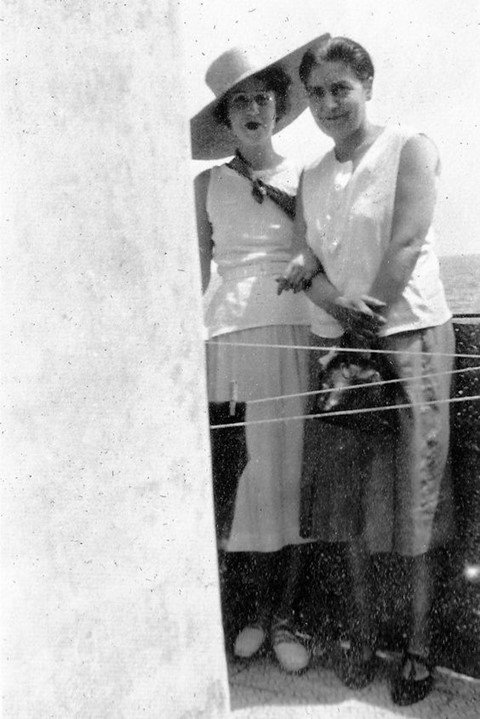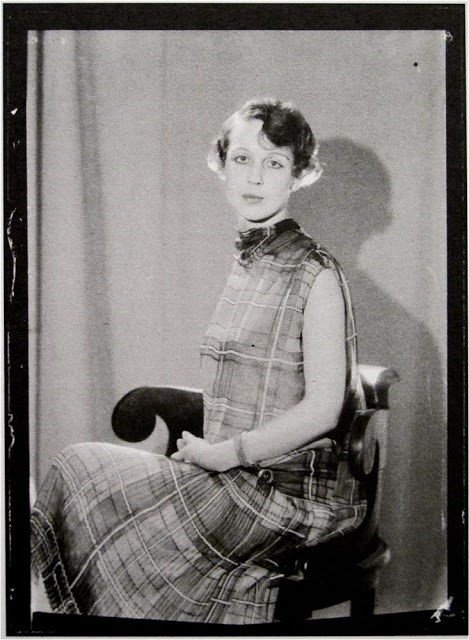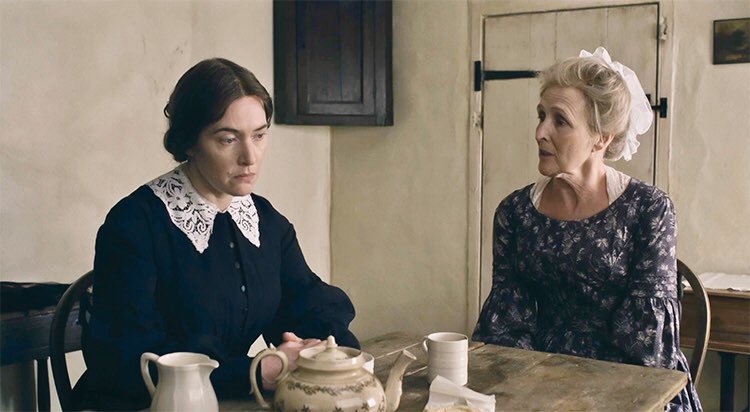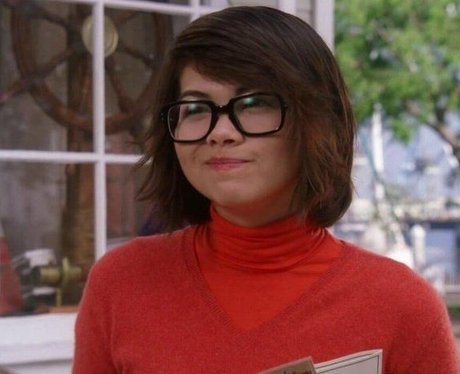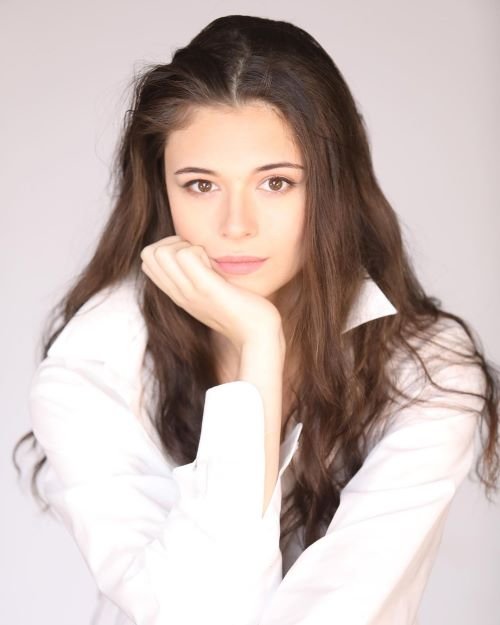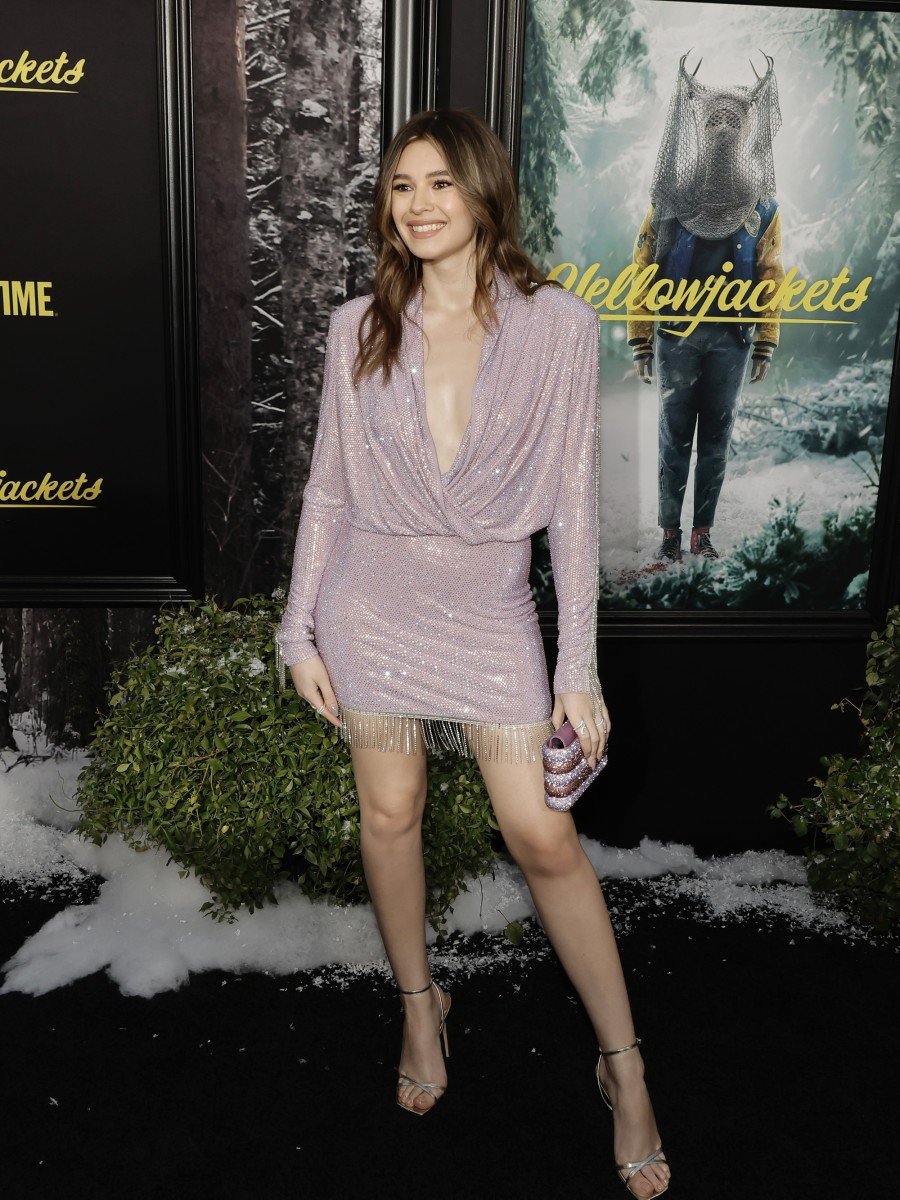Madge Garland (left) and Dorothy Todd (right)
Described as the ‘1920s lesbian power couple who transformed Vogue,’ Dorothy Todd as editor and Madge Garland as fashion editor ‘turned the magazine into a Modernist bible.’ Credited with bringing the likes of writers Virginia Woolfe and Aldous Huxley and photographer Cecil Beaton to the publication, their endeavors of creating a magazine ‘with serious avant-garde intentions’ were sadly short lived.
Little is known of Dorothy’s early life, but in 1922, aged 39, she was appointed the second ever editor of British Vogue (which had started up just a few years prior during WWI when it was impossible to get the American edition across the Atlantic). She was a ‘self-assured’ and ‘quick’ woman. Arriving shortly after her was 24-year-old recently-married Madge Garland. Madge, whose maiden name was McHarg, had been born in Australia and due to a spinal condition, had spent most of her childhood in a steel corset. Her interest in fashion flourished in Paris, but her parents refused to allow her to attend Cambridge for further study, so she ended up working as an errand girl in London before eventually finding employment as a receptionist at Vogue. Although she and her husband divorced just a year into the marriage, Madge continued to use his surname when she was informed by horticulturist and artist Gertrude Jekyll that ‘McHarg’ was ‘positively dreadful.’
Madge Garland
With Dorothy’s help, Madge soon transformed herself into ‘a figure of glamour and grace’ and was promoted by Dorothy to fashion editor. Between them, they began to move Vogue from largely ‘confining its pages to hats and frocks’ to a magazine that had ‘fashion editorials [sitting] alongside articles devoted to modernist art and literature.’ With contributions from some of the 20th century’s most forward-thinking creatives such as Virginia Woolfe, Aldous Huxley, Man Ray and Cecil Beaton, Vogue became ‘thoroughly modern, unapologetically intelligent, and implicitly queer in both tone and appearance.’
At the same time as their professional relationship was making strides, so too was their personal one. The couple lived together in a flat in London and hosted lavish parties that were attended by the likes of photographer and Oscar-winning stage designer Cecil Beaton, socialite and niece of Oscar Wilde, Dorothy Wilde, and cabaret singer Florence Mills.
Sadly though, their trailblazing time at Vogue was short lived. In 1926, Dorothy was fired due to ‘falling sales and dissatisfaction from her superiors about the direction of Vogue’s very contemporary drive.’ Condé Nast himself - founder of the mass media company that published Vogue, Vanity Fair and The New Yorker - thought Vogue was becoming too ‘bohemian.’ Dorothy threatened to sue him for breach of contract, but was told that ‘her “private sins” would be exposed’ if she didn’t let it go. It’s unclear whether these ‘sins’ referred to her rather openly gay relationship or her illegitimate daughter Helen (born in 1905) whose fraternity is unknown. For her part, Madge walked out in protest. It is said that the ‘Vogue staff stood in appalled solidarity with the pair. Several resigned in protest, and freelancers refused to accept commissions.’ Madge’s biographer, Lisa Cohen, would later write that this ‘firing and attendant disgrace devastated Todd and Garland.’
The couple did not stay together for too long after this. Dorothy had many debts, which it’s believed Madge paid off for her. She also started drinking and reportedly got into a habit of making Madge cry, however Madge later stated that ‘other people will say she ruined my life, she ruined my marriage, she gave me a terrible time. To hell. I have no regrets at all. She fostered me and she helped me. She opened many doors. I repaid that debt in full, because I supported her later in life. But I owed her more than I could ever repay.’
Madge managed to make a comeback in the industry and in 1934 was re-hired by Vogue as fashion editor before she was invited to become ‘the first professor of fashion’ at the Royal College of Art, a role she took on in 1948. In 1953, she married Sir Leigh Ashton, but it’s been alleged that this was a marriage of convenience as both parties were gay. They divorced in 1962 and Madge was later linked to other women in the art scene.
Dorothy, sadly, met with far less success in later life. In 1929 she published a book - The New Interior Decoration - with Raymond Mortimer and for some time is believed to have run a gallery but by WWII, she was working as a social worker. She lived in extreme poverty toward the end of her life and was described by her grandson as a ‘frail, scruffy old lady’ whose clothes were held together with pins. Despite this, Dorothy apparently managed to woo a young Italian woman who left her husband for her. Dorothy died in 1966 aged 83.
Born in Limerick in 1897, Kate O’Brien would go on to write some of the ‘earliest examples of Irish literature to feature homosexual themes,’ which also meant she was one of the earliest Irish writers ‘to fall foul of the censor’ with two of her books - Mary Lavelle (1936) and The Land of Spices (1941) being banned in Ireland.
Kate was one of ten children born into a well-to-do horse-dealing family. She was just five when her mother died, and so she was sent to join her older sisters in a convent school where she became the youngest boarder. In 1919, Kate graduated with a BA in English and French from UCD and after spending a year in London, moved to Spain where she worked as a governess and began her creative writing. Spain would have a profound impact on her writing, however, she wasn’t there a year before she suddenly returned to England and married Dutch journalist Gustaff Reiner. It is widely believed now that this was a lavender marriage (‘Renier was probably bi- or homosexual; O'Brien was lesbian’) and it only lasted a few months.
Kate’s first successful play - Distinguished Villa - was released in 1926, and following this, she took up writing full time. It was also about this time, according to her biographer Eibhear Walshe, that Kate began to have relationships with women, the first being Margaret ‘Stephie’ Stephens, who was ten years her senior.
Kate’s first novel - Without My Cloak - was published in 1931 and ‘charted the lives and loves of a middle class family from Mellick, [Kate]’s fictional version of Limerick’ and ‘won both the Hawthornden and James Tait Black Memorial prizes. In later works, [Kate] would refine the scope of her narratives to consider more in greater depth the topics of personal desire and sexualities in the context of family, religion and society.’ But these topics were not welcomed by the powers that were in Ireland at the time and as a result, her work came into conflict with the Censorship of Publications Board in Ireland (CPBI), which had been formed in 1929. Kate’s Mary Lavelle published in 1936 was subsequently banned by the CPBI for depicting ‘an adulterous relationship between a young Irish girl and a married Spanish man (as well as a declaration of love for the girl from an older Irish lesbian).’ Five years later, a second book, The Land of Spices, was banned over one single line that made reference to homosexuality: ‘She saw Etienne and her father, in the embrace of love.’ Her last completed novel, As Music and Splendour, released in 1958 but set in the 1880s/90s, centers the lesbian relationship of the fictional Irish opera singer Clare and Spanish singer Luisa.
The positive representations of queer characters in her novels has made Kate O’Brien a pioneer in queer literature, and while her books fell out of popularity toward the end of her life, her exploration of sexuality and desire for independence through strong female protagonists, meant that her novels were reclaimed in feminist circles in the 1980s and have continued to intrigue modern readers ever since. She is now considered one of the most important Irish writers of the 20th century.
Kate died, aged 76, in 1974.
Blues singer, pianist and all-round entertainer, Gladys Alberta Bentley was ‘one of the most well-known and financially successful black women in the United States in the 1920s and 1930s.’ Dressed in her signature tailcoat and top hat, Gladys was a staple of Harlem speakeasies where she would sing about her female lovers and flirt with women in the audience.
‘It seems I was born different. At least, I always thought I was.’
Gladys was born in 1907 in Philadelphia and from this moment had a strained relationship with her mother who had wanted a boy and so ‘refused to touch me. She wouldn't even nurse me and my grandmother had to raise me for 6 months on a bottle before they could persuade my mother to take care of her own baby.’ Gladys was relentlessly teased by peers and brought to doctors in an attempt to ‘cure’ her gender nonconformity, so at 16 she ran away to New York.
She settled in Harlem in the mid-1920s just as the Harlem Renaissance was taking off, and became ‘an instant sensation after performing at the most popular gay speakeasy, the Clam House.’ Of the Harlem Renaissance, curator of music and evolution of African-Americans in the 20th century Dwandalyn Reece, has said: ‘[it] is really a critical point in the history and evolution of African-Americans in the 20th century. The creativity that came out of that period shaped music, theater, dance, literature, intellectual thought and scholarship in a way that has shaped who we are today.’ And Gladys Bentley had a lot to contribute to that; her ‘overstated performance and appearance destabilized the conventional identity roles assigned within the divisions of black / white, woman / man, high class / low class, and homo- / heterosexual and reflected the possibility of, in Marjorie Garber’s words, a ‘category crisis.’’
‘...When she pounds the piano the dawn comes up like thunder.’ - author Carl Van Vechten
Through the 1930s, Gladys was the ‘primary attraction at the well-known Ubangi Club’ with a chorus of eight drag queens backing her up. As well as being a gifted pianist, singer and performer, Gladys was also an ‘adept provocateur.’ At one point, she told a gossip columnist that she had just gotten married and when the columnist asked who the man was, Gladys ‘scoffed and said, ‘Man? It's a woman.’’ While no official record exists to prove this marriage, it is ‘still a glimpse into Bentley’s unapologetic openness about her sexual orientation, and her acute understanding of the power of shock value.’ In the following decade, she relocated to California where she continued to perform.
With the decline of speakeasies (due to the repeal of Prohibition in 1933) and with the rise of McCarthyism in the 1950s which saw gay people labeled as national security risks, Gladys was more and more frequently harassed for her attire and how she acted. So, she started dressing conventionally in dresses and in an article for Ebony magazine, declared ‘I am Woman Again,’ stating that she had ‘cured her lesbianism via female hormone treatments.’ In 1952, she married a man sixteen years her younger (they later divorced) and claimed she was married to another man around this time too, although he denied ever marrying her. Over the next while, Gladys moved more toward the church; however just as she was to be ordained a minister, she died suddenly of pneumonia in 1960, aged just 52.
Born Fiona Wilson in Cork in 1958, Fiona Shaw is one of Ireland’s most recognisable actors across stage and screen (both big and small!) With accolades including two Laurence Olivier Awards for stage performances in the 1990s and a BAFTA Award for her performance in Killing Eve, Fiona has continued to engage audiences of all types since her debut in 1983.
After getting a degree in Philosophy from UCC, Fiona left for London in 1980 where she trained at the Royal Academy of Dramatic Art (RADA) and graduated two years later with the coveted Bancroft Gold Medal. Very soon after, Fiona was on the stage of the National Theatre, ‘garnering much critical praise for her role as Julia in Sheridan's The Rivals.’ Despite arriving in Hollywood at age 28 and being told ‘you’re very old,’ Fiona didn’t stick to just stage performances, appearing in the tv show The Adventures of Sherlock Holmes in 1984 and the award-winning My Left Foot in 1989. The following year, Fiona won her first Laurence Olivier Award for her performance in the lead roles of three major plays of the 1989 theatre season: Electra, As You Like It and The Good Person of Szechwan. Her second Olivier Award came just three years later in 1993 when she won for her performance in Machinal. In 1995, she took on the male lead role in The National Theatre’s ‘groundbreaking production’ of Richard II before performing T.S Elliot’s The Wasteland as a one-woman show to great acclaim in New York in 1996.
Fiona continued to appear on stage and screen throughout the end of the 1990s and became a household name in 2001 for her performance as Aunt Petunia in the Harry Potter franchise. She made her Broadway debut the following year in Medea, for which she was nominated for the Tony Award for Best Actress in a Play, the same year she began dating actor Saffron Burrows. Years later Fiona would tell a publication that realising she was gay ‘was a shock.’
‘I had this wonderful boyfriend, then another, then later I became gay. It was a shock. I was full of self-hatred and thought I would come back into the fold shortly. But I just didn’t. I wasn’t in any way gay until I was. One goes on developing.’
Sonali and Fiona at the 71st Emmys Governors Ball
The relationship came to an end in 2005, but in 2014 Fiona met and fell in love with Sri Lankan economist Sonali Deraniyagala after she read Sonali’s memoir about the 2004 Sri Lanken tsunami which claimed the lives of her husband, children and parents. Although they spoke only very briefly in their first encounter, Fiona says she came away from it feeling like she had ‘just met life’ and the couple married four years later.
More recently, Fiona has continued to entertain via the screen, with a BAFTA-award winning and two-time Emmy-nominated performance as Carolyn Martens in Killing Eve and an Emmy-nominated performance as supporting actress in Fleabag - a role which was created specifically for her by creator Phoebe Waller-Bridge. She also appeared in Ammonite, and Enola Holmes, one of Netflix’s most popular own movies, and as the titular character’s mother in the Star Wars TV series Andor, for which she was nominated for a Critics' Choice Super Award.
Now in her sixties, Fiona continues to amaze in the roles she takes on, be that on the stage, silver screen or in the movies, and there is promise of many more exciting performances to come.
Ranae Von Meding
Activist
Ranae was originally born in Chicago, moving to Dublin with her family at the age of 4. From a young age she was interested in the arts and at the age of 18 she began her training in performance arts. It was while in college she met her wife-to-be, Audrey. They began dating in 2008 and have lived and worked in Dublin ever since.
When Ranae became pregnant in 2016 with her and Audrey’s first baby, they didn’t expect that their child would be born unequal to other children in the eyes of Irish law. But when Ava was born, only one of her parents was allowed to be recorded on her birth certificate. Even though Audrey is Ava’s biological mother, only the birth mother - Ranae - was recognised, by law, as her parent. What this meant was that:
Audrey could not sign any forms to open a bank account for Ava and Ava was not allowed to inherit anything from Audrey or Audrey’s parents
Audrey was not allowed to consent to any medical treatment that Ava may need such as a blood transfusion, vaccinations or any surgery.
Audrey was not listed as her child’s parent and would only have been able to be listed on school forms as a ‘responsible adult’ who is allowed to collect her (but first she would have had to have been given consent from Ranae to do this)
Audrey was not allowed to travel with Ava without the written consent of Ranae.
Later, at a playgroup for children of LGBT+ parents, it was decided to start campaigning for change, and in 2019, after the birth of their second daughter Arya, they co-founded Equality for Children. For months they lobbied politicians, collected signatures on a petition and held demonstrations. As a natural storyteller, Ranae also began to publicize their fight through blog posts and the media.
In 2020, the Children and Families Relationship Act was brought in, but it was only life changing for some families. As Ranae explains, ‘If a child is born to two women, and meets all the criteria then they can have a claim to both of their parents. In order to meet that criteria, the child has to be conceived in a fertility clinic in Ireland, with an identifiable sperm donor that goes on a registry, and then that child has to be born in Ireland.’ Thankfully, with this new legislation, Audrey could be recognised as Ava and Arya’s parent alongside Ranae, after a somewhat delayed court process.
There are countless other LGBTQ+ families who are not covered by this Act, which is why Ranae and other couples are continuing the campaign for equality: ‘...for male couples there's nothing. Same-sex male couples or heterosexual couples, or a single person who goes through surrogacy - they're not in any way covered. That's what we're fighting for at the moment, legislation around surrogacy, retrospective recognition for kids already born through surrogacy, and then covering all the other same-sex female families who are left out of any legislation. So, that includes kids who are conceived in a clinic abroad, children who are born abroad, children who are conceived in a non-clinical setting.’
Outside of her campaigning, Ranae is a Marketing Manager with Thérapie Fertility. She is also a registered celebrant and solemniser and has been performing wedding ceremonies across Ireland since 2021. As she says herself, she ‘is a recovering perfectionist and people pleaser and adores cycling, horse riding and all forms of water.’
Learn more about the campaign here.
Thanks to Ranae for sharing her story with us.
Shannon Soule / BuzzFeed
Referred to as ‘lesbian Jesus’ by her fans, Hayley Kiyoko is familiar to most for her 4-episode portrayal of Alex Russo’s friend ‘Stevie’ in Wizards of Waverly Place back in 2010, but more recently, she has cemented herself as one of the most prominent voices in the queer music scene.
Born in Los Angeles, California in 1991, Hayley began acting at a young age, appearing first in national advertisements before graduating to tv and movies, however music was her main love throughout her school years. Taking up the drums aged 6, she founded a band named Hede in 2007 and released songs on MySpace and performed locally before the band broke up two years later. At the same time, Hayley was a member of the group the Stunners who were signed to Columbia Records and featured on the iCarly soundtrack before opening for Justin Bieber’s first world tour. But the group ‘fizzled out’ when Hayley decided she wanted more control over her music.
In 2009, Hayley starred as Velma in the live action Scooby-Doo! The Mystery Begins which went on to be Cartoon Network’s most-watched programme in its history at that point, with 6.1 million viewers. She reprised her role the following year, and also appeared on Wizards of Waverly Place as the protagonist’s friend, Stevie. Ever since, members of the LGBT+ community have felt that Stevie and Alex were more than just friends, and this was confirmed just recently by the showrunner who said ‘I wished we could have played more with what was quite obvious to a lot of us, which was the relationship between Stevie and Alex. We weren’t able to at that time, but it was pretty clear to all of us what that relationship was. That would have been fun.’
Hayley as ‘Stevie’ alongside Selena Gomez as ‘Alex’ in Wizards of Waverly Place
Sticking with Disney Channel, Hayley took on a leading role in the movie Lemonade Mouth, which premiered to over 7 million viewers in 2011. Two years later, she released her debut EP A Belle to Remember but it was her second EP This Side of Paradise, released in 2015, and particularly the single Girls Like Girls that saw Hayley garner a reputation as one of the leading sapphic voices in the queer music scene. The music video, directed by Hayley herself, ‘follows Coley and Sonya as they realize their love for each other extends beyond friendship.’
“I was so nervous because so many outlets didn't want to premiere it because it felt too — ‘explicit’ was a word that they used, even though it's just queer love. I was like, is anyone going to watch this video? Is anyone gonna relate to it?”
Upon release, the music video went viral, and is still referenced often today, eight years on. The song was also essentially a coming out moment for Hayley, who had only ever been out to her close friends and family up until this point, despite knowing she was gay since the age of 6. Seeing the reaction of fans, Hayley has said that she wished she would have embraced her true self sooner:
‘I think once you come out yourself as an artist, you're really allowing yourself to be your true authentic self because I was lying to myself for a long time as I was writing music. And I was so, so surprised to find my community once I released ‘Girls like Girls.’’
Source: Billboard
Hayley’s star has continued to rise since then. Her album Expectations released in 2018 and was followed by her debut live performance on the Jimmy Kimmel show. The same year, Taylor Swift invited her to perform with her on stage at the Gillette Stadium, which was followed a year later with an appearance in Taylor’s music video for You Need to Calm Down. Her most recent studio album, Panorama, released in summer 2022 after much anticipation, and in 2023 she kicked off The Panorama Tour in Glasgow. In May 2023, she will release her first novel - titled Girls Like Girls - a young adult story based on the characters from her 2015 Girls Like Girls music video.
‘Ever since I released the music video for ‘Girls Like Girls‘ [in 2015], it has been a dream of mine to tell the whole story of Coley and Sonya. I am so excited to explore these characters further in a novel — to really get inside their heads and their hearts, and to take readers on their quest for love. I am forever grateful for my fans who continue to champion me and help fuel my passion for storytelling.’
Nicole Maines
Actress / Activist / 1st person to portray a transgender superhero on television
(1997 - present)
Although just 25, Nicole Maines has been trailblazing for most of her life. In 2014 she won a landmark lawsuit against the Maine Supreme Judicial Court that established the right of trans students in the United States to use the bathroom that corresponds with their gender. Then, in 2018, she took on the role of ‘Nia’ in Supergirl, and became the first person to portray a transgender superhero on TV, blazing the way for others to follow.
Nicole and her twin brother Jonas were adopted at birth in 1997 and grew up in Maine, USA. Assigned male at birth, from the age of two, Nicole would ask her mother ‘when do I get to be a girl?’ and has more recently said that she knew she was not a boy from as young as three. Her brother was quick to accept her, and at nine, told their father - who was not as accepting - ‘Face it, Dad, you have a son and a daughter.’
When it came to choosing a new name, Nicole first wanted Raven (from Disney Channel’s That’s So Raven) but this idea was shot down by her father who insisted it was ‘not a real name’ but a ‘TV name.’ So next she chose Quinn for a character in Zoey 101, and when she couldn’t spell it, she landed finally on Nicole for a different character in the same show. But legally changing her name became a whole other hurdle when the family realised that per law in Maine, ‘name changes are announced in the newspaper.’ This was not what the Maines’ wanted for their child, particularly amidst local protests which were ongoing at that time by ‘a politically active organisation with vehemently anti-gay and anti-transgender views.’ So the only thing left to do was appear in court and ask the judge to allow Nicole to have her new name without needing to publicise it. After a sudden and impassioned plea by Nicole’s father (the first time he publicly supported his transgender daughter) the judge agreed that a private name change was what was best for Nicole, and allowed them to proceed. But unfortunately, this would not be the last time the Maines’ would appear in court.
Nicole with her father and brother after the Court ruled in their favour, 2014.
Source: Robert F. Bukaty
In 2007, when Nicole was in 5th grade (aged 10/11) a family member of a classmate complained that she was using the girls’ bathroom, causing her to be barred from using it again, and instead relegated to a staff bathroom. So the Maines family complained to the school district that their daughter was being discriminated against. Nothing came of this complaint, so they filed a lawsuit and eventually, the case made its way right up to the Maine Supreme Court. In 2014, the Court ‘ruled that the school district had violated the state’s Human Rights Act’ and awarded the family (and activist organisation, Gay & Lesbian Advocates & Defender who had assisted them) $75,000. It was a monumental win as it was ‘the first time in the nation that a court ruled it unlawful to force a transgender student to use the bathroom associated with the sex they were assigned at birth.’
Nicole as ‘Dreamer’ in Supergirl
The following year, Nicole and her family were the focus of a book by The Washington Post writer Amy Ellis Nutt, and in 2016 Nicole was one of a handful of people featured in the HBO documentary The Trans List through which she relayed her personal story of being transgender. In 2018, Nicole took on the groundbreaking role of TV's first trans superhero Nia (aka Dreamer) in Supergirl, and continued in this role across the Arrowverse family of shows, appearing in both Legends of Tomorrow and The Flash.
‘With trans folks we have a lot of people accusing us of just playing dress-up for whatever reasons, and that’s just not true. Having trans people play trans roles shows that we are valid in our identities and we exist.’
Superman: Son of Kal-El #13
Nicole’s connection to Nia has continued beyond TV; in 2021 and 2022 she co-wrote various comic books featuring her character in stories that will be woven into the DC comics universe. Although not a trained writer, the importance of this representation certainly hasn’t been lost on her:
‘It's a trans girl story written by a trans girl for trans girls. I'm really excited to bring that into the world.’
Source: Kevin Winter /Getty Images
Most recently, Nicole joined the cast of the hit show Yellowjackets in a recurring role alongside the likes of Juliette Lewis and Christina Ricci, and continues to be outspoken about trans representation in every facet of life. Her dad too, who originally was slow to accept her, has become a strong advocate for trans youth, attending rallies and reaching out to other parents of trans children to help them navigate what he and his family did over a decade ago.
‘I started talking to other dads about it and I said ‘Listen, what are you afraid of?’ Once they could verbalise what they were afraid of, then we could have the real conversations we needed to have [...] It just breaks my heart to see these kids come here and put themselves at risk to testify, to ask legislators ‘let me be who I need to be’.’
Biographies by Katelyn Hanna.
Sources:
Dorothy Todd & Madge Garland
‘The 1920s lesbian power couple who transformed Vogue,’ on Dazed Digital, online at: https://www.dazeddigital.com/fashion/article/38933/1/the-1920s-lesbian-couple-transformed-british-vogue-dorothy-todd-madge-garland [accessed 13 April 2023].
Jana, Rosalind, ‘The Forgotten Reign Of Radical British Vogue Editor Dorothy Todd Paved The Way For LGBTQIA+,’ on Vogue, online at: https://www.vogue.co.uk/arts-and-lifestyle/article/dorothy-todd-vogue [accessed 13 April 2023].
Medhurst, Eleanor, ‘FASHION HISTORY WAS NEVER STRAIGHT: MADGE GARLAND, DOROTHY TODD AND VOGUE,’ on dressingdyke.com, online at: https://dressingdykes.com/2020/11/27/fashion-history-was-never-straight-madge-garland-dorothy-todd-and-vogue/ [accessed 13 April 2023].
Christopher Reed, ‘A Vogue That Dare Not Speak its Name: Sexual Subculture During the Editorship of Dorothy Todd, 1922-1926,’ Fashion Theory 10.1-2 (2006): 46-47.
Cohen, Lisa, All We Know: Three Lives, (New York: Farrar, Straus and Giroux, 2012), p. 244.
‘DOROTHY TODD, THE VOGUE EDITOR WHO GAVE IT A QUEER CULTURE INJECTION,’ on Blue17, online at: https://www.blue17.co.uk/vintage-blog/dorothy-todd-the-vogue-editor-who-gave-it-a-queer-culture-injection/ [accessed 14 April 2023].
Kate O’Brien
‘Ireland's banned authors in the DIB,’ on DIB, online at: https://www.dib.ie/blog/irelands-banned-authors-dib [accessed 22 Mar. 2023].
Slater, Sharon, ‘KATE O’BRIEN A PIONEER IN GAY LITERATURE,’ on Limerick’s Life, online at: https://limerickslife.com/kate-obrien/ [accessed 22 Mar. 2023].
‘O’Brien, Kate,’ on DIB, online at: https://www.dib.ie/biography/obrien-kate-a6479 [accessed 22 Mar. 2023].
O’Neill, Margaret, ‘Kate O’Brien: Literature Writer, Wanderer, Revolutionary,’ on Women’s Museum of Ireland, online at: https://www.womensmuseumofireland.ie/exhibits/kate-obrien [accessed 22 Mar. 2023].
‘Kate O’Brien,’ on Making Queer History, online at: https://www.makingqueerhistory.com/articles/2022/7/26/kate-obrien [accessed 23 Mar. 2023].
‘Ireland's banned authors in the DIB,’ on DIB, online at: https://www.dib.ie/blog/irelands-banned-authors-dib [accessed 23 Mar. 2023].
Battista, Anna, ‘Book Review: Kate O'Brien, As Music and Splendour,’ on Erasing Clouds, online at: http://www.erasingclouds.com/wk3805obrien.html [accessed 23 Mar. 2023].
Gladys Alberta Bentley
Anders, Tisa, ‘GLADYS BENTLEY (1907-1960),’ on Black Past, online at: https://www.blackpast.org/african-american-history/bentley-gladys-1907-1960/ [accessed 24 Mar. 2023].
Shah, Haleema, ‘The Great Blues Singer Gladys Bentley Broke All the Rules,’ on Smithsonian Magazine, online at: https://www.smithsonianmag.com/smithsonian-institution/great-blues-singer-gladys-bentley-broke-rules-180971708/ [accessed 24 Mar. 2023].
Wilson, James F., Bulldaggers, Pansies, and Chocolate Babies: Performance, Race, and Sexuality in the Harlem Renaissance (Ann Arbour, 2010), p. 173.
‘Gladys Bentley,’ on QueerCulturalCenter.org, online at: https://web.archive.org/web/20200419163723/https://queerculturalcenter.org/gladys-bentley/ [accessed 11 April 2023].
Fiona Shaw
‘Patron: Fiona Shaw,’ on Irish Film London, online at: https://www.irishfilmlondon.com/patron-fiona-shaw [accessed 24 Mar. 2023].
‘Killing Eve star Fiona Shaw opens up about her coming out journey,’ on Gay Times, online at: https://www.gaytimes.co.uk/culture/killing-eve-star-fiona-shaw-opens-up-about-her-coming-out-journey/ [accessed 24 Mar. 2023].
Carvajal, Edduin, ‘Fiona Shaw Dated Men before Realizing Her Sexuality & Feeling 'Self-Hatred' — Meet Her Wife Sonali Deraniyagala,’ on AmoMama, online at: https://news.amomama.com/288667-fiona-shaw-dated-men-realizing-her-sexua.html [accessed 24 Mar. 2023].
Saner, Emine, ‘Fiona Shaw: ‘I got to Hollywood at 28 and they said: You’re very old’,’ on The Guardian, online at: https://www.theguardian.com/tv-and-radio/2021/jul/14/fiona-shaw-baptiste-fleabag-hollywood [accessed 24 Mar. 2023].
‘Profiles in Pride: Fiona Shaw, genius of the stage and silver screen,’ on IrishCentral, online at: https://www.irishcentral.com/culture/pride-fiona-shaw [accessed 24 Mar. 2023].
Hayley Kiyoko
Smith, Katie Louise, ‘Wizards of Waverly Place boss confirms Alex and Stevie were meant to be a couple,’ on PopBuzz, online at: https://www.popbuzz.com/tv-film/news/wizards-of-waverly-place-alex-stevie-gay-couple/ [accessed 11 April 2023].
Tanner, Erik, ‘#20gayteen: The Year of Hayley Kiyoko,’ on Rolling Stone, online at: https://www.rollingstone.com/music/music-features/how-hayley-kiyoko-became-lesbian-jesus-695667/ [accessed 11 April 2023].
Moore, Mat, ‘Hayley Kiyoko says that she knew she was gay from the age of six,’ on Gay Times, online at: https://www.gaytimes.co.uk/culture/hayley-kiyoko-says-that-she-knew-she-was-gay-from-the-age-of-six/ [accessed 11 April 2023].
Factora, James, ‘Hayley Kiyoko Says Every Young Role Was “Foreshadowing” Her Future Self,’ on them, online at: https://www.them.us/story/hayley-kiyoko-disney-coming-out-lesbian-jesus-interview [accessed 11 April 2023].
Gulla, Emily, ‘Why Hayley Kiyoko decided to label herself as a lesbian,’ on Cosmopolitan, online at: https://www.cosmopolitan.com/uk/love-sex/a28695639/hayley-kiyoko-label-lesbian/ [accessed 11 April 2023].
Washington, Jasmine, ‘Hayley Kiyoko Announces New “Girls Like Girls” Young Adult Novel,’ on Seventeen, online at: https://www.seventeen.com/celebrity/a41645160/hayley-kiyoko-girls-like-girls-young-adult-novel/ [accessed 12 April 2023].
Nicole Maines
Ellis Nutt, Amy, ‘Becoming Nicole,’ in The Washington Post, online at: https://www.washingtonpost.com/sf/national/2015/10/19/becoming-nicole/ [accessed 13 April 2023].
Harrison, Judy, ‘Maine Supreme Court rules in favor of transgender girl in Orono school bathroom case,’ Bangor Daily News (30 Jan. 2014).
Stout, David, ‘Transgender Teen Awarded $75,000 in School Restroom Lawsuit,’ in Time, online at: https://time.com/3615599/transgender-student-restroom-lawsuit-maine/ [accessed 13 April 2023].
Wratten, Marcus, ‘Wayne Maines raised TV’s first trans superhero. Now, he’s fighting for trans kids everywhere,’ on Pink News, online at: https://www.thepinknews.com/2023/03/24/wayne-maines-nicole-maines-first-trans-superhero-interview/ [accessed 13 April 2023].
Dart, Chris, ‘Nicole Maines went from playing trans superhero Dreamer on the CW, to writing the new series,’ on CBC, online at: https://www.cbc.ca/arts/q/nicole-maines-q-tom-power-interview-1.6797810 [accessed 13 April 2023].
Lopez, Julyssa, ‘Actress and Activist Nicole Maines Will Be TV's First Transgender Superhero,’ in Glamour, online at: https://www.glamour.com/story/actress-and-activist-nicole-maines-will-be-tvs-first-transgender-superhero [accessed 13 April 2023].
